Study demonstrates range of salinity options for shrimp production in commercial-scale systems
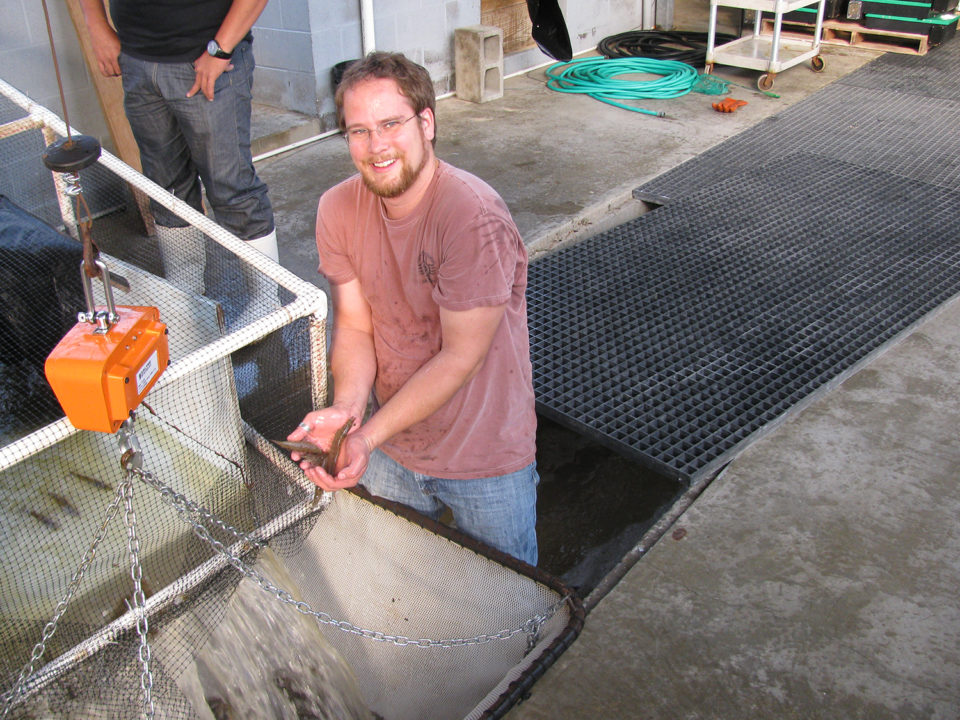
Intensive, biofloc-based, minimal-water-exchange systems operate under low rates of water exchange, reducing or eliminating pollution from effluent, significantly improving biosecurity, and possibly facilitating inland production of aquatic, marine organisms.
These intensive, biofloc-based, minimal-water-exchange systems can be built inland, away from the coast, in lower-cost land and closer to major urban areas where demand for fresh, never-frozen shrimp can be very significant.
However, some water must be replaced even in minimal-exchange systems to manage solids and control the accumulation of contaminants like nitrate and metals. Consequently, imported seawater or artificial sea salts can be a substantial expense in inland systems, supporting their operation at the lowest salinity possible to optimize financial performance.
The isosmotic point for Pacific white shrimp is reported to be 24.7‰ salinity. The technical literature has conflicting reports regarding the growth rates of Pacific white shrimp being compromised at salinities below the isosmotic point – and some studies found no difference in shrimp survival between different salinities.
The ionic composition of saltwater can vary based on its origin, but only the concentration and ratios of a few major ions are most important for culture of Pacific white shrimp. Although Pacific white shrimp has been produced in the United States – mostly in outdoor ponds and at relatively low stocking densities of 10 to 40 cubic meters in outdoor ponds – at salinities of 1 to 15‰ in Alabama, Arizona, Florida and Texas, available information is inadequate regarding commercial-scale shrimp production in intensive biofloc systems at low or moderate salinities.
This article is adapted and summarized from the original publication (Aquaculture 476 (2017) 29–36), which compared water quality and shrimp production in a biofloc-based, commercial-scale culture facility and at three different salinities. Grants from the U.S. Department of Agriculture’s U.S. Marine Shrimp Farming Program supported the research. We thank Reginald Blaylock, Verlee Breland, Kevin Dillon, Christopher Farno, Casey Nicholson, Eric Saillant, Bonnie Seymour, and the staff of the GCRL Physical Plant.
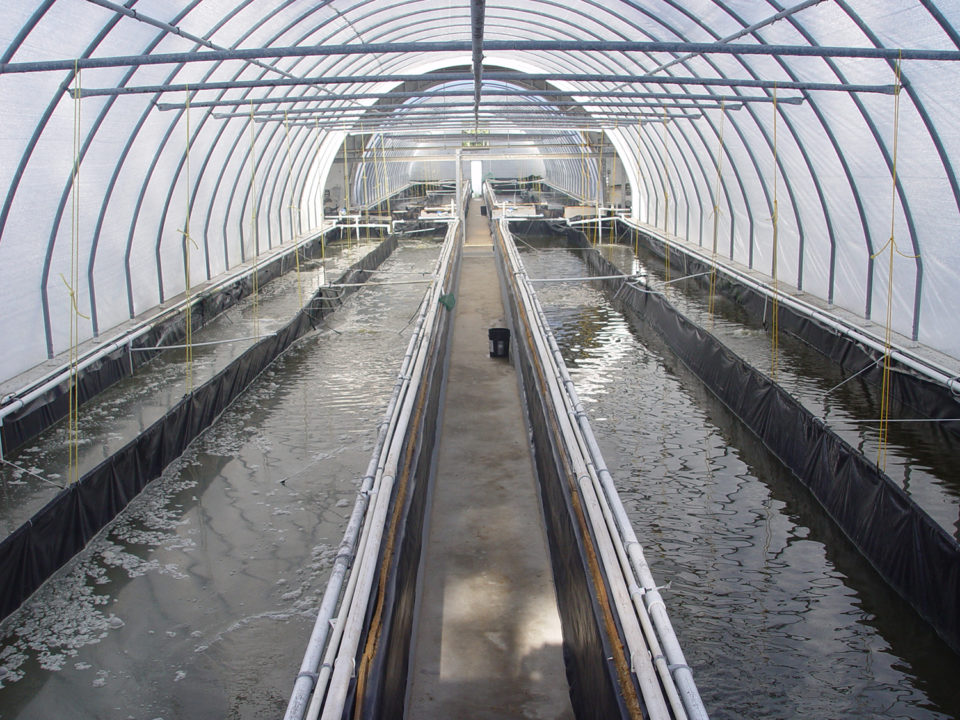
Study setup
We conducted our study during winter months at the University of Southern Mississippi’s Thad Cochran Marine Aquaculture Center (CMAC), located in Ocean Springs, Miss., USA. Eight-day-old postlarvae (PL8) of Pacific white shrimp from a commercial producer in Islamorada, Fla., were stocked at 4,000 shrimp per cubic meter in 30.1 by 3.2-meter raceways located in dome-shaped greenhouse structures covered in clear plastic. Boilers were used to control water temperature.
Shrimp postlarvae were first reared in a nursery raceway for 54 days at a salinity of 25‰, with sucrose added periodically to increase the C:N ratio and encourage heterotrophic bacterial assimilation of ammonia on an as needed basis. Animals were initially fed (for the first 16 days of nursery) with freshly hatched artemia sp. from INVE Aquaculture, and beginning on the first day and through the nursery phase, shrimp were fed various nursery feeds from Zeigler Brothers, Inc. with varying crumble sizes according to the size of shrimp. During the nursery phase, shrimp were fed based on a percent of the assumed shrimp biomass, starting at 15 percent of biomass and gradually decreasing to 8.8 percent.
Shrimp were sampled at the end of the nursery phase and weighed 1.22 ± 0.02 grams (mean ± SEM). Animals were then enumerated by weight and 12,500 shrimp were placed into each of nine production raceways, identical to the one used for the nursery phase, except that only four airlift devices were contained in each raceway, and Venturi nozzles were added to increase aeration and promote water circulation. These nine raceways were each randomly assigned to different salinity treatments: a low salinity (10‰) treatment (LS), a medium salinity (20‰) treatment (MS), and a high salinity (30‰) treatment (HS).
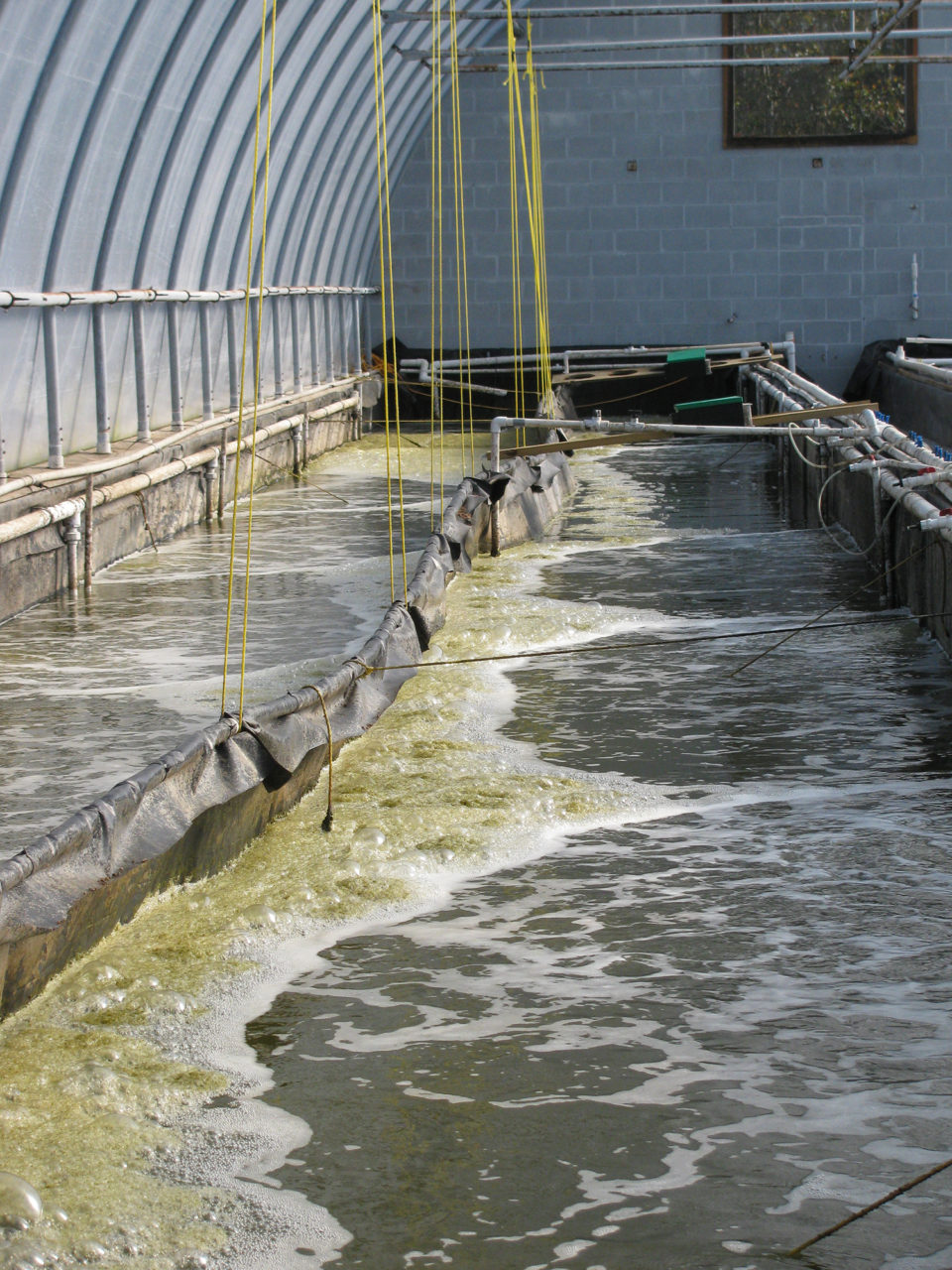
For the first nine days after shrimp were moved to the growout raceways, both the Zeigler PL 40-9 Vpak diet and the Zeigler Hyperintensive-35 diet were provided, after which only Zeigler
Hyperintensive-35 diet was given. Feed rations were calculated such that no uneaten feed could be found in the raceways 30 minutes prior to each feeding. Each raceway received the same amount of feed at every feeding. Shrimp weights were estimated once per week by weighing five groups of 10 shrimp from each raceway, and the animals were experimentally reared for eight weeks.
For more detailed procedures on the experimental setup – including shrimp source, nursery and feeds; experimental systems and design; water quality; systems management; shrimp culture; and data management and analysis – refer to the original publication.
Results and discussion
The shrimp production metrics resulting from this study were generally at commercially-acceptable levels irrespective of salinity values (Table 1). A mortality event in one of the LS raceways resulted in lower shrimp production in that treatment. However, there were no significant differences in any shrimp production metric between treatments. Growth rate was high and feed conversion ratio (FCR) was low, and the appearance of harvested shrimp was good.
Ray, biofloc salinities, Table 1
| Parameter | LS | MS | HS |
|---|---|---|---|
| Growth rate (g/week) | 1.8±0.1 | 2.0±0.0 | 2.0±0.1 |
| FCR | 1.6±0.2 | 1.2±0.0 | 1.2±0.0 |
| Mean weight (g) | 17.8±0.9 | 19.3±0.2 | 19.0±0.5 |
| Biomass (kg) | 149.5±19.2 | 188.2±5.7 | 195.5±3.5 |
| Biomass/volume (kg/m3) | 3.0±0.4 | 3.8±0.1 | 3.8±0.1 |
| Survival (%) | 68±10 | 78±2 | 81±1 |
The centralized heating system maintained water temperature at 29 degrees-C with little variability, but there were significant differences in temperature between the treatments for both morning and afternoon measurements: MS > LS > HS, although differences in mean values were small. The significant differences in temperature between treatments was likely due to the location of raceways relative to the hot water delivery system.
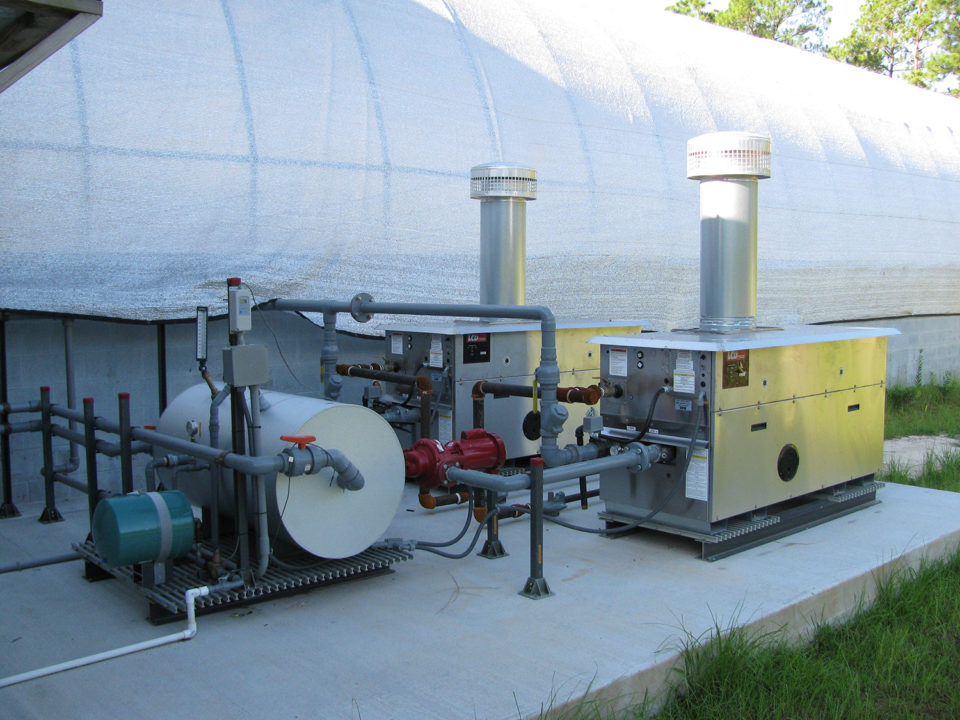
Salinity levels in the raceways were steady throughout the study and were significantly different between treatments. The concentration of the major ions corresponded with salinity, but there were significant differences between HS and LS calcium and potassium values. Regarding pH, it was significantly higher in the LS treatment, followed by the MS and then the HS treatments.
The reason for lower pH values with increasing salinity observed in the study was not clear. Our observed relationship between salinity and pH could have been due to potentially increased photosynthesis in the lower salinity treatments.
The dissolved oxygen (DO) concentration was relatively consistent and was maintained at a high level to ensure it did not reach stressful levels. There were significant differences between treatments with respect to morning DO concentration: HS > MS > LS; and there were significant differences in DO levels between the LS and MS treatments and between the HS and MS treatments: HS, LS > MS.
The concentration of settleable solids was significantly greater in the HS treatment compared to the LS treatment and there were no significant differences between the MS treatment and any other treatment. There were no significant differences between treatments with respect to turbidity.
The concentration of ammonia increased substantially in all but one HS raceway during week five of the study. Ammonia concentration increased again in most raceways the last week of the experiment. There were no significant differences in ammonia concentrations between treatments. Nitrite concentration increased to 1.4 and 1.5 mg NO2-N/L in two HS raceways during week six.
There were no significant differences between treatments regarding five-day BOD. There were no significant differences in chlorophyll-a concentration between treatments. The mean volume of full salinity seawater (35‰) used per kg of shrimp produced in the LS, MS, and HS treatments was 104, 159, and 235 L, respectively (Table 2). There were no significant differences among treatments with respect to the total volume of water used (52.4, 52.3, 52.6 cubic meters respectively). The estimated cost of artificial sea salts (assuming only artificial salts are used), based on those used at the CMAC, is also depicted in Table 3.
Ray, biofloc salinities, Table 2
| ITEM | LS | MS | HS |
|---|---|---|---|
| Total 35 ppt seawater used per raceway (m3) | 15.0±.01a | 29.8±0.0b | 45.1±0.0c |
| 35 ppt seawater used per kg shrimp (L/kg) | 104±14a | 159±5b | 235±4c |
| Total water exchange (%) | 5.0±0.3 | 4.5±0.1 | 5.2±0.0 |
| Cost (US$) of artificial sea salt per raceway | 653.8±2.2a | 1300.8±0.7b | 1964±0.2c |
During the study, intensive monitoring of salinity and pH and the regular inputs of fresh water and sodium bicarbonate supported consistent pH and salinity. The uniform temperature, pH, DO and salinity may have contributed to the resulting high shrimp production, because a more constant physical environment helps minimize stress for aquatic animals.
Our study demonstrates the benefits of maintaining relative consistency in water quality parameters and the potential for substantial savings in seawater by growing marine shrimp at lower salinities. When considering the price of artificial sea salts for any aquaculture facilities located away from the ocean, these water savings represent direct cost savings. The low rate of water exchange during this study also helps to lower seawater use and justify inland shrimp aquaculture. Water was only exchanged as a result of solids removal. Several similar trials conducted at the Oceanic Institute (OI) in Hawaii were reported to have used 187, 172, and 402 liters of seawater per kg of shrimp.

Perspectives
The significantly lower production in the LS treatment would result in lower profit for a commercial shrimp operation, even though there were no significant differences in shrimp production between the treatments evaluated.
Although uncertain, the unplanned introduction of anaerobic material could have caused the same level of mortality in the higher salinity treatments. But the estimated cost of artificial salts was 49.7 percent lower in the LS treatment vs. the MS treatment, which would represent higher profit margins for shrimp producers.
When deciding the salinity at which to culture shrimp, production goals and availability and cost of sea salt should be considered. In addition, because oscillations in ammonia and nitrite are common in intensive biofloc-based systems, these should also be considered. Our research shows that the three salinities studied can result in comparable shrimp production in commercial-scale biofloc systems.
Now that you've reached the end of the article ...
… please consider supporting GSA’s mission to advance responsible seafood practices through education, advocacy and third-party assurances. The Advocate aims to document the evolution of responsible seafood practices and share the expansive knowledge of our vast network of contributors.
By becoming a Global Seafood Alliance member, you’re ensuring that all of the pre-competitive work we do through member benefits, resources and events can continue. Individual membership costs just $50 a year.
Not a GSA member? Join us.
Authors
-

Andrew J. Ray, Ph.D.
Corresponding author
Assistant Professor of Aquaculture Production
Division of Aquaculture
Kentucky State University
Land Grant Program
103 Athletic Rd.
Frankfort, KY USA[117,100,101,46,117,115,121,107,64,121,97,114,46,119,101,114,100,110,97]
-
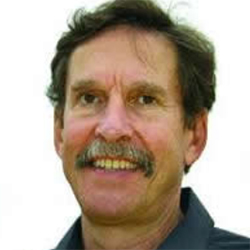
Jeffrey M. Lotz, Ph.D.
Professor
Division of Coastal Sciences, Gulf Coast Research Laboratory
The University of Southern Mississippi
703 East Beach Drive
Ocean Springs, MS USA
Tagged With
Related Posts
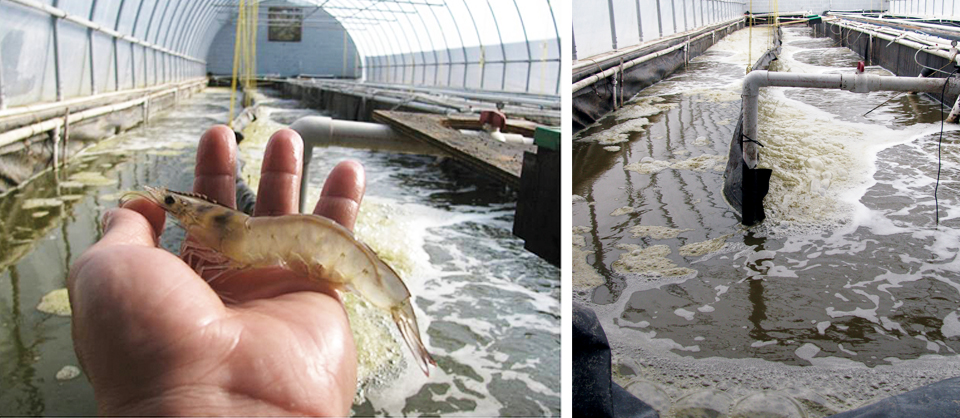
Health & Welfare
Biofloc trial results in fast shrimp growth, low FCR, high survival
A trial in a lined, greenhouse-enclosed raceway evaluated the use of a heterotrophic biofloc system equipped with aeration, supplemental oxygen injection and centralized heating to achieve good shrimp production.
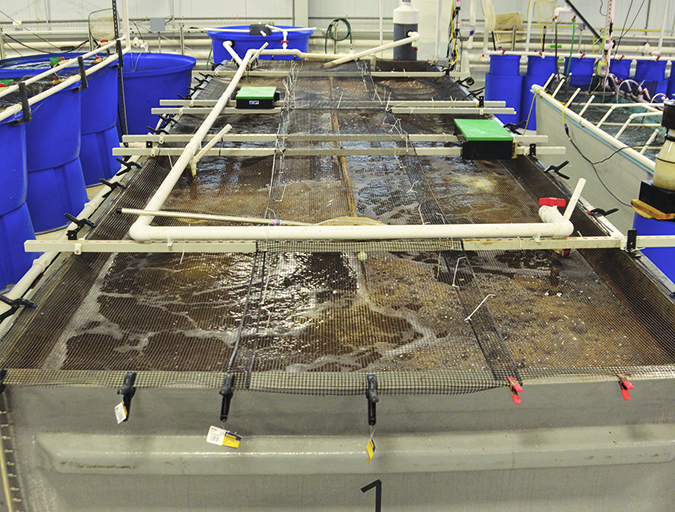
Intelligence
Indoor-raised shrimp find potential market in Kentucky test
By raising shrimp in a closed building, producers can increase biosecurity, produce shrimp more consistently, grow shrimp year-round and locate production centers near markets. Chefs and consumers were very accepting of whole fresh shrimp, offered at a farmers market, that was farmed indoors in Kentucky.
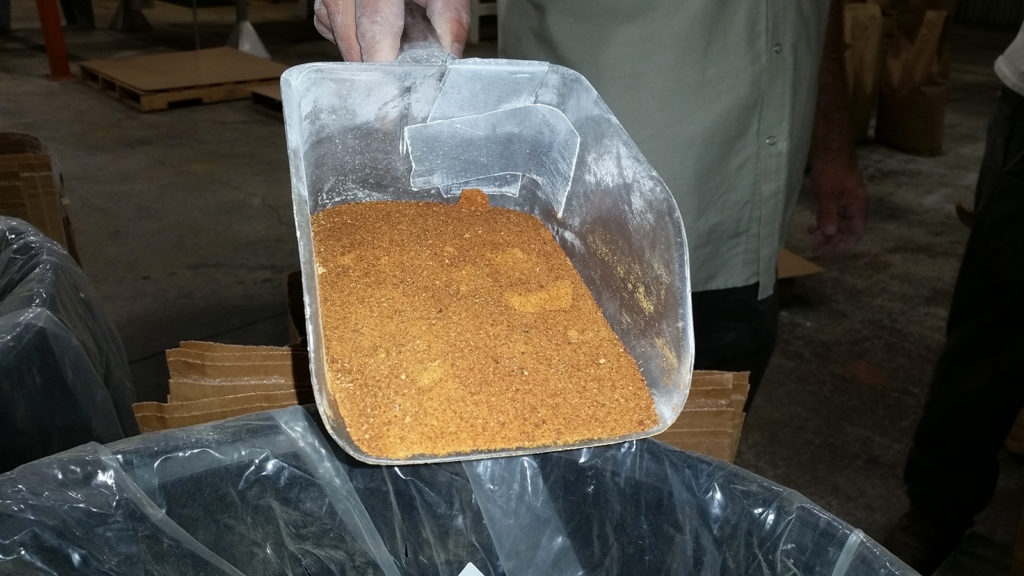
Aquafeeds
Nutritional evaluation of improved soybean meal in Pacific white shrimp diets
Results of a study show that alternative, sustainable, plant-based protein sources such as improved soybean meal may potentially replace fishmeal in Pacific white shrimp diets.
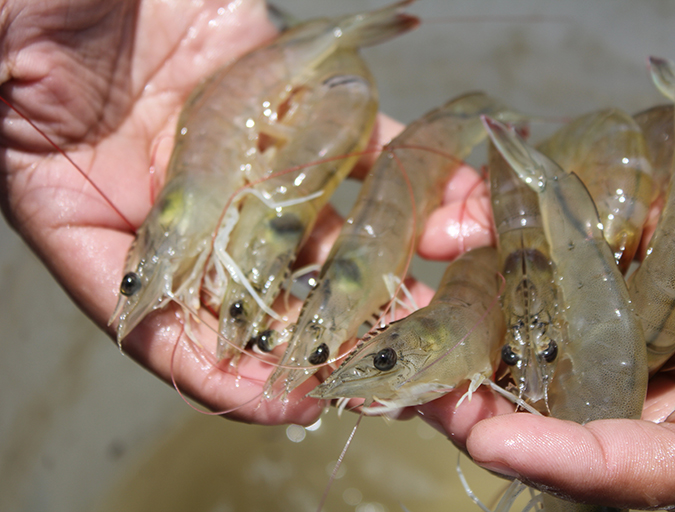
Aquafeeds
Testing shrimp growth in different biofloc systems
A study conducted with juvenile shrimp (Litopenaeus vannamei) reared in experimental biofloc systems used four treatments. Results indicate that differences in management and carbohydrate source can lead to substantial disparity in system function and production.


